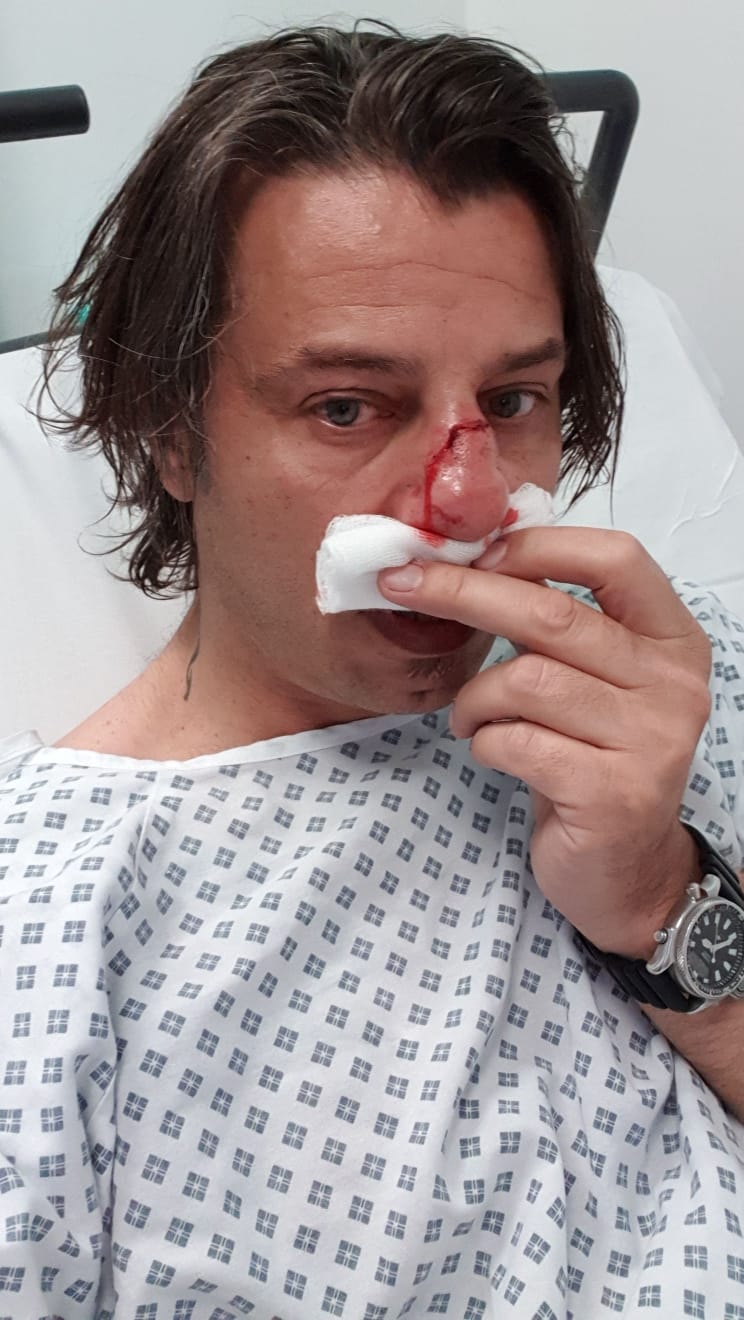When Corrado Amitrano, an Italian freelance photojournalist, arrived at Westminster on Saturday to shoot the far-right “statue defenders” protest in London, he wasn’t anticipating ending up in hospital with a broken nose and six stitches.
Corrado was attacked by an unidentified group of people in Parliament Square and Whitehall. The aftermath of the violent incident – showing onlookers jeering as Corrado climbs over a barricade to receive medical attention – was captured on film and shared on social media. The video has since been viewed over 500,000 times on Twitter. By the end of the day, 23 police officers had sustained minor injuries, along with Corrado and another journalist.
“It was an attack against the media,” Corrado tells VICE News. “The Black Lives Matter rally the [far-right] came to counter-protest was called off, so I guess there were only police officers or members of the press for some to release their adrenaline against.”
Corrado got to Westminster around 11:30AM that morning, aiming to photograph the far-right groups who took to the streets to supposedly protect the Winston Churchill statue and the Cenotaph from acts of vandalism. Within half an hour of his arrival, protesters were already trying to break a police cordon, he says.
Photographers and video journalists were recording the clashes just behind the line of officers. Corrado recalls that it only took a few seconds for the crowd to break through and surge past the police. “‘Fucking media! Fucking media!’ – this is what they were screaming. I was not the only journalist there, but I was probably the person who got the worst out of it,” he remembers.
At first, he was hit on the head by a plastic bottle. Sensing danger, Corrado tried to leave the scene when he spotted a camera operator on the floor, holding his photo tripod and camera as protesters kicked him. “He was screaming, so my instinct was to try to reach him.” As Corrado bent down to grab the man, he was punched hard in the face. “Someone out of sight hit me and broke my nose. After that, it was an explosion of kicks, punches, whatever you can imagine.”
Corrado recalls blacking out for a second. He tried to walk away, in a state of confusion, but the crowd kept pushing him back into the fray. “I remember a middle-aged man who pushed me back into the fight when I was desperate to leave and my nose was already broken – I won’t ever be able to understand how you can do such a thing to another human being.”

It was only after he managed to leave the scene that he was spotted by two police officers, who carried him out of the protest and called an ambulance to take him to St. Thomas’ Hospital.
More than 100 people were arrested for assaulting police officers, violent disorder and possession of offensive weapons in and around the protest in central London. As yet, the Metropolitan Police has not released an official statement regarding Corrado’s attack.
Corrado isn’t aware of an investigation to find those who assaulted him or any other journalists present at the scene, but says he isn’t planning to lodge a formal report. VICE News has reached out to the Metropolitan Police for comment on the incident.
Even if the attackers are detained, the courts cannot charge them for actively hampering the work of media. This is why the National Union of Journalists is calling on the UK government to support a national plan to protect journalists, and to promote the International Federation of Journalists’ draft UN convention on the safety and independence of journalists and other media professionals.
Dr. Carmen Draghici, a law academic at City, University of London, has been working alongside the IFJ to push the international community to protect journalists like Corrado. “[The] current international law does not recognise the specific risks associated with the journalistic profession,” she said in evidence presented to Parliament. “There are no binding norms to establish safeguards for journalists, and freedom of expression provisions in general human-rights treaties do not reflect journalists’ constant exposure to risks of attacks on account of their profession.”
At a time of increasing global violence against the media, Draghici believes that setting up an international independent judicial body with the mandate of protecting members of the press will mean that “victims will have an effective avenue for redress, and domestic authorities will be pressured into compliance”.
As Corrado holds up his blood-splattered Nikon camera, he is keen to stress this point: “I was attacked for having a camera in my hand, that’s a fact.” But he emphasises that his injury alone shouldn’t be the sole focus of the discussion: “I only took two pictures. They prevented me from doing my job, showing what I see, covering the event. When journalists are intimidated, it means our overall situation is getting really bad.”
from VICE https://ift.tt/3fvRUdK
via cheap web hosting
No comments:
Post a Comment